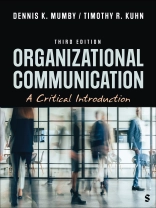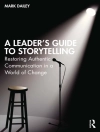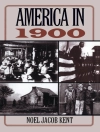Organizational Communication: A Critical Approach, Third Edition presents a modern, critical perspective while providing a comprehensive survey of theory and research in organizational communication. Authors Dennis Mumby and Timothy Kuhn familiarize students with the field of organizational communication—historically, conceptually, and practically—and challenge them to reconsider their common sense understandings of work and organizations, preparing them for participation in 21st century organizational settings. Linking theory with practice, Mumby and Kuhn skillfully explore the significant role played by organizations and corporations in constructing our identities. The text has been extensively revised, recognizing that the world has changed significantly between editions including the rise of social media, the increasingly networked character of organizational life, the emergence of AI, and more. Critical analysis of the relationship between communication and organization has never been more important, and the updates provide a current look into the critical issues that students will face as they navigate their work lives.
Mục lục
Preface
Acknowledgments
About the Authors
Part I: Conceptualizing: A Critical Communication Perspective On Work And Organizations
Chapter 1: What Is Organizational Communication?
Defining Organizational Communication: The Communication–Organization Relationship
Organizations as Communicative Structures of Power
Conclusion
Critical Applications
Chapter 2: Studying Organizational Communication Critically
Understanding Theory in the Critical Analysis of Organizational Communication
Unpacking the Critical Approach
Understanding Organizational Communication From a Critical Perspective
Conclusion
Critical Applications
Part II: Contextualizing: A History Of Theorizing Work And Organizatons
Chapter 3: Fordism And Organizational Communication I: Classical Theories
The Fordist Organization
Fordism And Scientific Management
Fordism And Bureaucracy
Conclusion
Critical Applications
Chapter 4: Fordism And Organizational Communication II: The Human Relations School
Placing Human Relations Theory In Its Historical Context
Fordism, Mayo, And Human Relations Theory
Mary Parker Follett: Bridging Theory And Practice
Fordism And Human Resource Management
Conclusion
Critical Applications
Chapter 5: Organizations as Communication: Systems and Constitutive Views
Situating the Systems Perspective
The Principles of the Systems Perspective
The Communicative Constitution of Organization
Conclusion
Critical Applications
Chapter 6: Communication, Culture, and Organizing
The Emergence of the Cultural Approach
Three Perspectives on Organizational Culture
Conclusion
Critical Applications
Part III: Applying: A Critical Communcation Approach To Work And Organizations In The 21st Century
Chapter 7: Post-Fordism And Organizational Communication
The Fall Of Fordism And The Rise Of Post-Fordism
Neoliberalism As An Economic System
Neoliberalism As A Hegemonic Discourse
Post-Fordist Work: A New Organizing Model
Communicative Work And Communicative Capitalism
Conclusion
Critical Applications
Chapter 8: Communicating Gender At Work
The Four “Waves” Of Feminism
Critical Feminism: Viewing Organizations As Gendered
Conclusion
Critical Applications
Chapter 9: Communicating Difference At Work
Defining Difference at Work
Putting Difference and Workplace Diversity in Historical Context
Difference and Diversity in the Contemporary Workplace
Interrogating Whiteness and Organizational Communication
Conclusion
Critical Applications
Chapter 10: Branding, Work, And Organization
Branding And Capitalism In The 20th Century
The Evolution Of Branding: Three Models
Work, Branding, And The Enterprise Self
The Ethics Of Branding
Conclusion
Critical Applications
Chapter 11: Leadership Communication in the New Workplace
Traditional Perspectives on Leadership
New Approaches to Leadership
A Critical Communication Perspective on Leadership
Conclusion
Critical Applications
Chapter 12: Information and Communication Technologies in and at Work
Understanding Technology
New Technologies, New Challenges
ICTs and the Extension of the Workplace
Conclusion
Critical Applications
Chapter 13: Globalization and Corporate Social Responsibility
Defining Globalization
Spheres of Globalization
Organizing Against Globalization
Globalization and Corporate Social Responsibility
Conclusion
Critical Applications
Chapter 14: Organizational Communication And Meaningful Work
Meaningful Work
Meaningful Work And Identity
The Future Of Work
Conclusion
Critical Applications
Giới thiệu về tác giả
Dennis K. Mumby is the Cary C. Boshamer Distinguished Professor of Communication at The University of North Carolina at Chapel Hill, USA. His research focuses on the communicative dynamics of organizational control and resistance under neoliberalism. He is a Fellow of the International Communication Association, and a National Communication Association Distinguished Scholar. He has authored or edited 7 books and over 60 articles in the area of critical organization studies, and his work has appeared in journals such as Academy of Management Review, Management Communication Quarterly, Organization Studies, Organization, and Human Relations. He is past chair of the Organizational Communication Division of NCA, and an 8-time winner of the division’s annual research award. He has served as chair of the Organizational Communication Division of the International Communication Association, and is a recipient of the division’s Fredric M. Jablin Award for contributions to the field of organizational communication.












